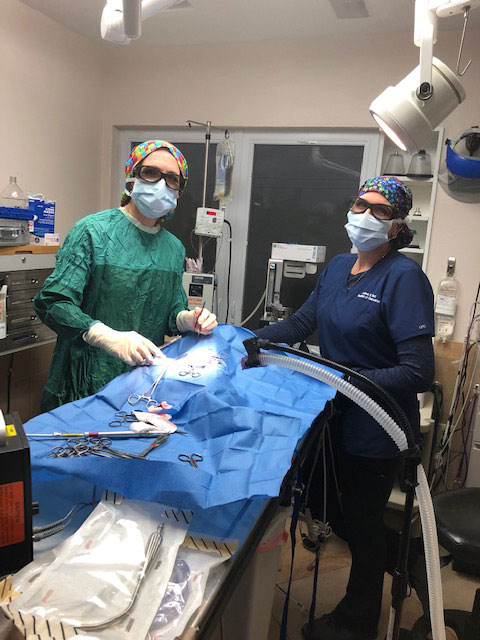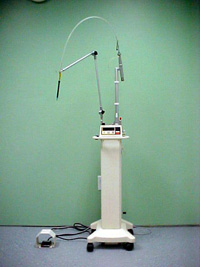Surgical Procedures
CO2, Laser Surgery
 Dog and cat surgery is an important aspect of every animal hospital’s activities. Here you will see some close-up photos of dog and cat surgeries, read explanations of what our surgeons are doing and why they are doing it. We feel it is very important that our clients understand what it is that’s medically wrong with their pets or what the surgical procedure being done consists of.
Dog and cat surgery is an important aspect of every animal hospital’s activities. Here you will see some close-up photos of dog and cat surgeries, read explanations of what our surgeons are doing and why they are doing it. We feel it is very important that our clients understand what it is that’s medically wrong with their pets or what the surgical procedure being done consists of.
Modern veterinary surgery on dogs and cats is done under conditions designed to minimize the chances of bacterial contamination and reduce the possibility of infections. Instruments, gowns, towels and other items such as scalpels and clamps are sterilized in an autoclave at 270 degrees under pressure for various lengths of time to kill any microorganisms. The surgeon also scrubs their hands and wears sterilized surgical gloves and wears a gown if the surgery is more than a minor procedure. By adhering to sterile surgical techniques, postoperative infections are rare.
After any surgical procedure the pet’s owner is given a thorough description of what our surgeon accomplished and what is now expected of the pet owner in terms of post-operative home care. Sometimes that can be a bigger challenge than the surgery! How do you make a happy and carefree dog “take it easy” for ten days? How do you make a cat not jump off the back of the couch? Nevertheless, aftercare is vital to the healing process and we will do all that we can to help you through that process.
Laser Surgery
 A Co2 laser is used to perform various surgeries including neutering, de-clawing, tumor excision, entropion eye surgery and aural hematomas. The use of a laser for surgery is less painful for your pet. The laser creates a much more precise cut than a traditional scalpel, which means there is less swelling, less bleeding, and less pain at the incision site allowing your pet a faster recovery.
A Co2 laser is used to perform various surgeries including neutering, de-clawing, tumor excision, entropion eye surgery and aural hematomas. The use of a laser for surgery is less painful for your pet. The laser creates a much more precise cut than a traditional scalpel, which means there is less swelling, less bleeding, and less pain at the incision site allowing your pet a faster recovery.
What is a laser?
A laser generates a highly focused beam of light that can vaporize (cut) or seal (weld) tissue.
What is laser surgery?
In laser surgery, a highly focused laser beam efficiently vaporizes the living tissue while simultaneously sealing capillaries, small blood vessels, lymphatics, and nerve endings, with significant benefits to both patients and surgeons.
What is the most efficient soft-tissue surgical laser?
 CO2 surgical laser remains the dominant soft-tissue surgical laser in human and veterinary medicine for over 30 years. The interaction of CO2 laser’s infrared laser light with living tissue provides a fundamentally different approach to surgery. The diameter and power of the laser beam may be adjusted to achieve a desired control over the tissue removal, and the laser is equally adept at excisions, ablations and incisions.
CO2 surgical laser remains the dominant soft-tissue surgical laser in human and veterinary medicine for over 30 years. The interaction of CO2 laser’s infrared laser light with living tissue provides a fundamentally different approach to surgery. The diameter and power of the laser beam may be adjusted to achieve a desired control over the tissue removal, and the laser is equally adept at excisions, ablations and incisions.
Laser surgery benefits for patients
Less Bleeding
The laser seals small blood vessels as it cuts; this enables a number of surgical procedures that are not practical with conventional scalpel.
Less Pain
The CO2 laser beam seals nerve endings and lymphatics as it cuts, resulting in less pain and edema; the patient experiences a more comfortable post-operative recovery.
Reduced risk of infection
The CO2 laser beam efficiently kills bacteria in its path, producing a sanitizing effect.
Quicker recovery time
Reduced risk of infection, less bleeding, less pain and less swelling often allow the patient a far more rapid return to normal activities after laser surgery.
Laser surgery benefits for surgeons
Unique surgical capabilities
Laser surgery advances many surgical procedures by making them simpler or by reducing risk; this enables procedures that are not practical with conventional scalpels.
Enhanced visibility of the surgical field
The laser beam seals capillaries and small blood vessels as it cuts, thereby dramatically reducing bleeding, resulting in a much drier and clearer surgical site.
Reduction of surgery time
The hemostatic effect of the laser beam and the improved visibility of the surgical field often reduce the amount of time required to perform the surgery.
Increased precision and control
The diameter of the beam may be adjusted down to a small fraction of a millimeter or expanded to address a much wider coverage. The power of the beam may set for rapid removal of relatively large tissue amounts, or adjusted to remove only one or two cell layers at a pass.

Contact Us
Regular check ups with a veterinarian are important for your pet's health. Contact us today to schedule your next appointment.





